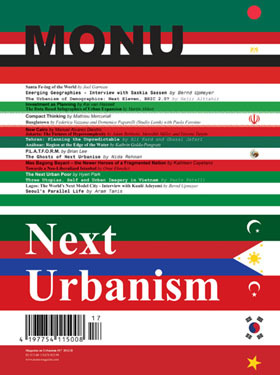
MONU’s latest issue on Next Urbanism explores the pre-existing and future possibilities of the eleven countries, identified by Goldman Sachs, that are predicted to follow in the BRIC economies footsteps. It is unsurprising that these countries will generate speculation following the years of interest and research surrounding the BRIC phenomena. Despite the Next Eleven being less cohesive as a grouping, the 17th issue of Magazine on Urbanism did reveal a collection of common themes, one of the most prominent, the significance of networks that traverse spatial, municipal and national boundaries. As Saskia Sassen states in her interview, with Editor Bernd Upmeyer, it is more cogent to analyse the emerging urban geopolitics and the increasing collaboration between global cities. The future urban networks and geopolitical vectors will hold a noticeable importance over the current conventional hierarchies, particularly with regards to the speed and efficiency of transnational collaboration and exchange. Essays by Joel Garreau, Paolo Patelli, Kathleen Cayetano and Studio Lunik reveal a growing typology of networks materialising with the availability and proliferation of technology. Each contributor explores the individual nuances of their distinct geographies and socio-economic groupings. As Joel Garreau states, with a digital age, urban may come to describe aggregation and dispersal patterns. Urban centres, rather than being used primarily for work or necessity, may hold the attraction for the experiential event. Whilst this may be initially only an option for the affluent populations, with the precipitous drop in technology costs, conceivably in the future it will be a universal alternative.

Technology has already connected great numbers of people both nationally and internationally in countries such as Bangladesh, the Philippines and Vietnam. Contributions from Studio Lunik and Kathleen Cayetano touch on previous governmental policies and the resulting effects that encouraged the migration of significant numbers of the Bangladeshi and Filipino populations. Many infrastructures were bypassed within these countries for more advanced technological options as a consequence of the influence of this group in their respective cities over the decades. The essays also raise questions of the role of migrant populations in supporting development through remittances and whether we may witness a leapfrogging effect in urban development. In contrast, Paolo Patelli’s essay on Vietnam’s increasingly networked public sphere highlights the digital publics that inhabit the physical spaces of cities and how these are a part of wider, overlapping global networks. This application of technology appears to be instigating a resurgence of street life and political participation in the Next Eleven.
Essays by Manuel Alvarez Diestro, Nida Rehman and Onur Ekmekci call attention to the rights and relationships of the general city population, particularly the urban poor, in the city planning process. Alongside the contributions of Hyeri Park, Ali Fard and Ghazal Jafari, additional themes of the dominance of affluence and authority in top-down policy making emerge. If one of the main drivers of Next Urbanism is foreign investment, how do cities in these economies balance economic growth with economic equality? If the chief priority of policy makers is growth, do we in turn see a de-politicization of public space and a spatially manifested widening gap between the rich and poor instigated by urban renewal practices as some contributors suggest? Or as Nida Rehman points out, are the abandoned construction projects of some centres a memorial to democratic resistance of urban citizens rather than the aftermath of a global recession? It appears that most of the cities of the Next Eleven are still struggling to create socially equitable space and face severe challenges in the form of aggressively insensitive gentrification that has less to do with improving the living conditions of pre-existing inhabitants and more with appealing to investment portfolios. A worrying conclusion of this process is the isolation of inhabitants and their growing detachment from society, which Hyeri Park points out, if unaddressed, could lead to social conflict in the future.
Despite the problems, all the essays suggest multiple forms of ingenuity and resourcefulness. Kai van Hasselt and Mathieu Mercuriali ‘s contributions see Next Urbanism as a testing ground for planning and infrastructure. As Kunle Adeyemi states the biggest assets of these emerging economies are the people and their human infrastructure. Their innovation can be clearly seen by the appropriation of informal spaces both in creating new housing typologies when displaced from their old residences in South Korea to the entrepreneurship seen in the slum communities of Nigeria. As a result major cities in these geographies are becoming hubs for mobility, businesses, and leisure. With their increasing growth, much of the investment is being directed into infrastructure to provide a logical structure to their physical development. New infrastructures will have to seek an ecological equilibrium in their cities as essays by Hajir Alttahir and Kathrin Golda-Pongratz state. Older and more urbanised cities within the N-11 will have to rehabilitate past interventions in their city fabric that are exacerbating conditions for the current urban populations. Golda-Pongratz’s essay argues that traditional views of urban design and water were more holistic for certain topographies such as Anahauc and current models of urbanisation are unsuitable for the future ecological security of the area. Adam Bobbette, Meredith Miller, and Etienne Turpin’s essay on the cityness of Jakarta also touches upon water urbanism and the politics of design. Contemporary plans to create predictability with regards to risk, and disaster planning have resulted in a disparity of understanding, and a displacement of communities.
MONU 17 offers a fascinating glimpse into some of the realities of Next Eleven conditions and current speculations. Next Urbanism, however it may be defined in the future, is a topic that requires further exploration and refinement. The contributors have provided a wide-ranging collection of thought provoking perspectives that have as much relevance outside of this grouping as in them.
Issue 17 is available to view and buy from http://www.monu-magazine.com/issues.htm.
Architecture and urbanism ramblings from an over-caffeinated postgrad.